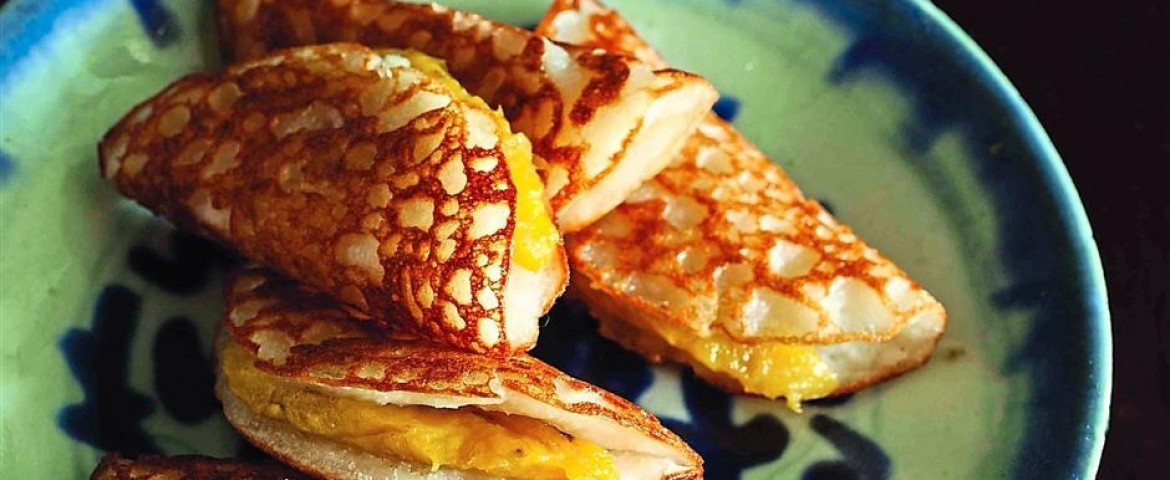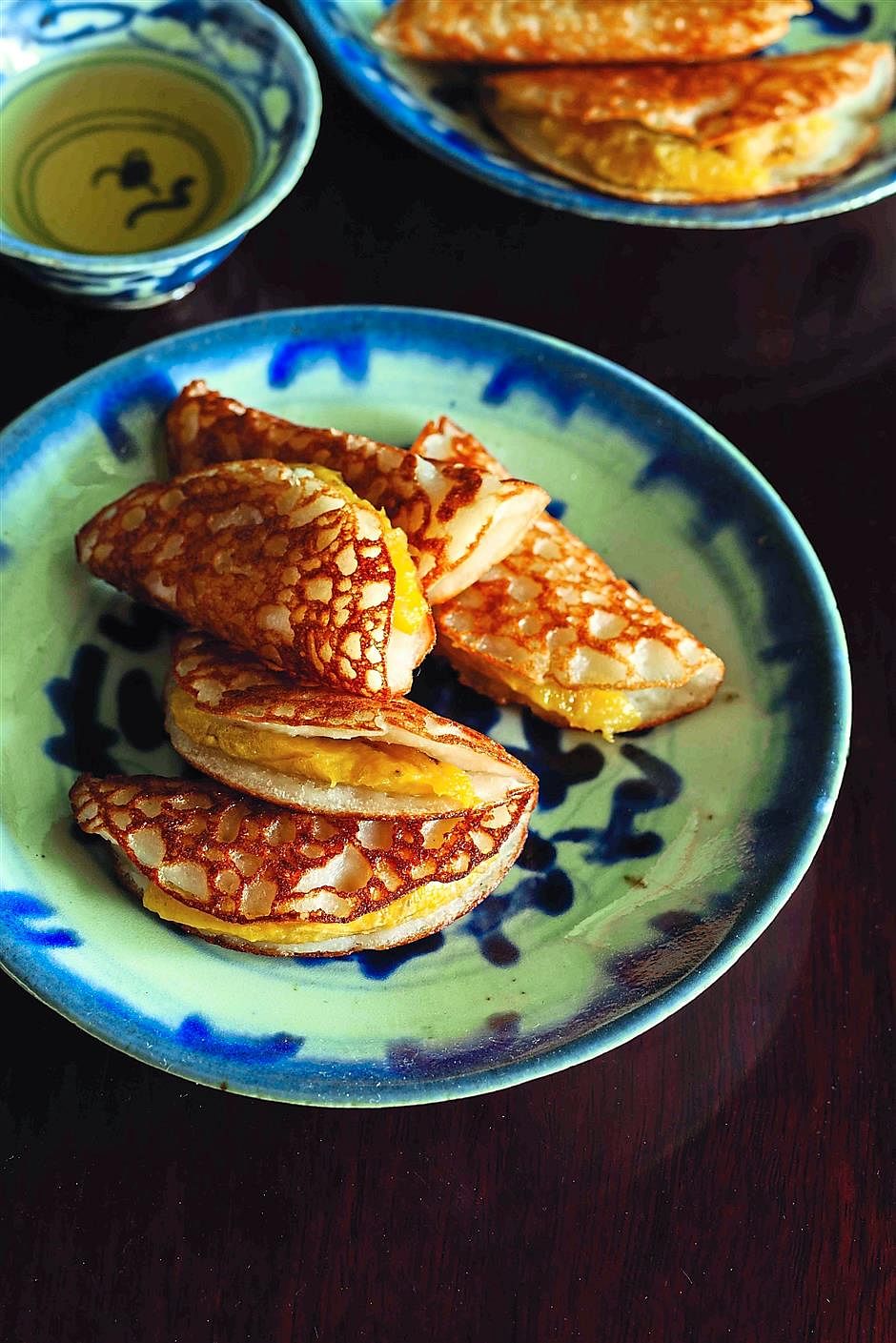3 Nonya recipes for apom balik, chicken or mutton curry and roti jala
Sign up now: Weekly recommendations for the best eats in town

Apom balik, also known as apong balek, is a popular Nonya dessert.
PHOTO: NONYA HERITAGE KITCHEN / THE STAR
Follow topic:
MALAYSIA (THE STAR/ANN) - "Nonya cuisine is an early example of fusion food, one that evolved from this integration of Malay and Hokkien food with the colonial cuisines of Portugal, the Netherlands and England," Dr Ong Jin Teong writes in his book, Nonya Heritage Kitchen - Origins, Utensils And Recipes.
In it, Ong has tried to find out if popular food, cooking techniques, ingredients and utensils interacted to create Nonya or Peranakan cuisine. The Peranakan culture is the result of the intermarriage between Chinese - predominantly Hokkien men and Malay women from the 15th century onwards.
Here are three recipes from the book courtesy of Dr Ong Jin Teong.
APONG BALEK

Ingredients:
50g rice flour
4 tsp glutinous rice flour
1 Tbs cornflour
30g sugar
¼ tsp fast-acting yeast
100ml water
100ml coconut milk
1 egg
50g grated coconut
3 small bananas
1 small tin cream-style sweet corn, drained
Cooking oil
50g rice flour
4 tsp glutinous rice flour
1 Tbs cornflour
30g sugar
¼ tsp fast-acting yeast
100ml water
100ml coconut milk
1 egg
50g grated coconut
3 small bananas
1 small tin cream-style sweet corn, drained
Cooking oil
Method:
1. For the batter: Mix the flours, sugar and yeast together and gradually add water and then the coconut milk to obtain a consistent batter. Set aside for at least 1 hour.
1. For the batter: Mix the flours, sugar and yeast together and gradually add water and then the coconut milk to obtain a consistent batter. Set aside for at least 1 hour.
2. Beat egg and mix into the batter with the grated coconut. There should be tiny bubbles in the batter.
3. Peel bananas and slice them about 3-4mm thick. Set aside.
4. Cooking the pancakes: Heat up the pan till it is hot. Turn off heat and wipe bottom and side with a paper towel dipped in oil. Set the pan on low heat.
5. Stir batter. Spoon enough batter onto the pan to make a ¼cm-thick, 10cm diameter round pancake. Cover pan with lid.
6. When the pancake batter turns from opaque to a more transparent white, place 1-2 slices of banana on one half of pancake, then sprinkle some creamed corn around banana.
7. The temperature is too high if the edges of the pancake browns at this stage. If that happens, turn off the heat for about 30 seconds before covering the pan again.
8. When the edge browns, lift the edge to check if the bottom is also brown. If so, fold the pancake over to form a semi-circle. Remove the apong balek and cool on wire rack. Repeat till all the batter has been used up.
Makes 12
CHICKEN OR MUTTON CURRY
You can grind the spice paste using a batu giling or lesong, or in an electric blender.

Ingredients:
1kg meat, chicken or mutton
600g potatoes, peeled and cubed
250g (about 4) tomatoes, quartered
For the spice paste:
2 cloves garlic, chopped
200g shallots, sliced
3 Tbs chilli powder or 25g dried chillies
4 Tbs coriander powder
1 Tbs cumin powder
1 Tbs fennel powder
1 tsp turmeric powder or 20g fresh
150ml water
½ cup oil, preferably coconut oil
4cm old ginger, sliced
1 star anise
6cm cinnamon stick
4 cloves
5 cardamoms, crushed
4 stalks lemongrass, crushed
150ml coconut milk
1 tsp salt or to taste
1kg meat, chicken or mutton
600g potatoes, peeled and cubed
250g (about 4) tomatoes, quartered
For the spice paste:
2 cloves garlic, chopped
200g shallots, sliced
3 Tbs chilli powder or 25g dried chillies
4 Tbs coriander powder
1 Tbs cumin powder
1 Tbs fennel powder
1 tsp turmeric powder or 20g fresh
150ml water
½ cup oil, preferably coconut oil
4cm old ginger, sliced
1 star anise
6cm cinnamon stick
4 cloves
5 cardamoms, crushed
4 stalks lemongrass, crushed
150ml coconut milk
1 tsp salt or to taste
Method:
1. Cut the meat into cubes or chunks and set aside.
1. Cut the meat into cubes or chunks and set aside.
2. To make the spice paste: Grind garlic and shallots in a food processor, then add the ground spices and the water, blending into a fine paste.
3. To cook (tumis) the spice paste: Heat up a wok or blangah claypot. Add oil and spice paste. Stir on low to medium heat for 10 minutes. Add sliced ginger and whole spices. Continue to tumis until the oil separates from the paste and it darkens in colour - about 15 to 20 minutes. Add a tablespoon water if the spice paste is too dry and sticks to the wok.
4. To cook the curry: Add 50ml coconut milk, 500ml water and the meat. Stir well, bring to boil. Add potatoes and bring to boil again. Add tomatoes and simmer 20 minutes, till meat is soft.
5. Add 200ml hot water, the rest of the coconut milk and salt. Mix well and heat on low to medium heat, stirring occasionally. When it has boiled, reduce heat and simmer for a few minutes. Serve with rice, nasi kunyit, roti jala or roti canai.
ROTI JALA
Also known as fishnet crepes or lacy pancakes

Ingredients:
600g flour, sifted
½ tsp salt
½ tsp turmeric powder
6 eggs
100ml milk or coconut milk squeezed from half a grated coconut
850ml water
oil
600g flour, sifted
½ tsp salt
½ tsp turmeric powder
6 eggs
100ml milk or coconut milk squeezed from half a grated coconut
850ml water
oil
Method:
1. To prepare the batter:Combine flour, salt and turmeric. Beat eggs, one at a time, into the mixture. Now add coconut milk gradually, stirring to get a smooth, thick paste. Add water, a little at a time and stir well. If batter is lumpy, strain it.
1. To prepare the batter:Combine flour, salt and turmeric. Beat eggs, one at a time, into the mixture. Now add coconut milk gradually, stirring to get a smooth, thick paste. Add water, a little at a time and stir well. If batter is lumpy, strain it.
2. Test the batter - it should flow out the funnels in a continuous stream. If it flows out in droplets, it is too thick - add more water and test again. If too watery, add more flour. Let batter rest for at least 30 minutes before using.
3. To make roti jala: Heat a non-stick pan. Grease pan with paper towel dipped in oil. Place roti jala cup over a bowl to collect the drippings. Ladle batter into cup to ¾ full. Hold bowl with one hand and cup with the other hand. Move bowl and cup over pan. Move cup over pan, making circular or figure eight patterns to form a lacy crepe of about 20cm diameter. Return the cup to the bowl once you have a lacy crepe.
4.The roti jala is ready when it separates from the pan at the edges. The roti jala is cooked on one side only. Lift pan and tilt it to allow roti jala to slide onto a plate. Fold crepe into eighths. Arrange on serving plate. Repeat with remaining batter. Serve roti jala with chicken and potato curry.
Note: If you do not have a roti jala cup (mould), make a funnel with a piece of banana leaf secured with a bamboo toothpick and use this. You can also use a plastic squeeze bottle with multiple spouts used in pastry or even those used by your hairdresser.

